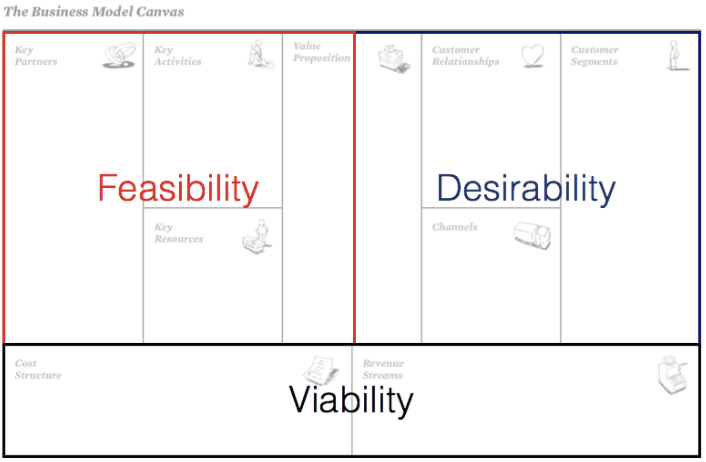Three Lenses of Innovation
(Thanks for reading, I’ve recently written a newer, better version of this article here)
A large part of my work is teaching people how to use the Business Model Canvas, created by Strategyzer.
It’s a profound and minimalistic tool, which can change the way you think about your enterprise and the philosophy behind your organization.
(If you’re using the Canvas, you’ll love my free Business Modelling eBook, full of tips for inventing and testing ideas that will change the world)
Surprisingly, in order to get good at the skill of business modelling, the canvas isn’t the best starting point.
The brain can’t handle ten boxes of new terminology machine-gunned at it, especially if you haven’t had a coffee. Instead, there’s an even better framework.
It’s called “The Three Lenses of Innovation”, and was created by IDEO.
Tim Fife from Second Road introduced it to me, and now I get to introduce it to you.
Desirability, Feasibility, Viability
Here’s how to think about it; in order to run a successful business, we have to create something that is Desirable (people want it), Feasible (we can actually do it) and it has to be Viable (we don’t go broke).
We can’t afford to get any of these wrong.
Therefore, we need to examine our business through each lens, to see how we’re going and what could be improved.
The Desirability lens asks you to look at your customer;
How do they hear about you?
What brings them in the door?
What keeps them coming back?
Maybe you have a few different types of customers; can you articulate what each group finds most appealing?
The Feasibility lens focuses on the “back of house” aspects of your operation.
What needs to go on behind the scenes in order to create the magic for your customer?
Key staff members?
A recognizable and trusted brand?
Partnerships with industry leaders?
Ask yourself; what minor change to our operations would be diabolical?
What do we have in place to prevent that from happening?
The Viability lens is about the dollars.
Where do they come from?
Where do they get spent?
What’s our breakeven point?
Which of our customers are most profitable, and are we doing anything to pursue them?
There are no right or wrong numbers, but not knowing your numbers is inexcusable.
How can we make decisions about the future if we don’t have financial clarity?
What often happens is a series of gradual adjustments; a change to the Desirability leads to a tweak to the Feasibility, and now our Viability is a little worse.
How do we get back on course?
Another change, leads to another, leads to another, until you spiral inwards towards the intersection of the three lenses, where success lives.
Over time, the market shakes up your model, and will push you away from the centre.
Your job as an entrepreneur is to be vigilant, and constantly re-evaluate things through all three lenses.
This is where the Strategyzer Canvas comes in. It’s exactly the same thing, just with clearer terminology and a neater layout.
The right side is about Desirability, the left about Feasibility, and the bottom line is the bottom line, Viability.
This is how to get started on the Canvas.
Keep tweaking and modifying, ensuring that after making changes to one side that the others haven’t been thrown off.
You will not get it perfect on the first go.
Nobody does.
My first canvases were atrocious, but nobody told me about the Three Lenses approach.
Don’t fall in love with your first attempt, and work towards a model that can deliver you an enterprise that works.
You might enjoy the series on the Business Model Canvas.
If you’d like to jump straight to a particular section, go to:
Overview: How To Use The Business Model Canvas
Desirability: Customer Segments, Value Proposition, Customer Relationships, Channels
Feasibility: Key Resources, Key Activities, Key Partners
Viability: Cost Structure, Revenue Streams








